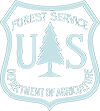History of Policies Leading to the Cohesive Fire Strategy
Following an intense fire season, the National Fire Plan was developed in the year 2000. This plan had five major objectives and a 10-year strategic plan (later revised in 2006):
- Firefighter response improvement
- Rehabilitation on landscapes affected by wildland fire
- Reducing hazardous fuels
- Assistance to communities
- Committing to the Wildland Fire Leadership Council
In 2002, the Healthy Forest Initiative expanded on two of these objectives--reducing hazardous fuels on federal lands and promoting community involvement in planning for fire protection. The 2003 Healthy Forest Initiative Act provided the legislative power to implement the initiative, but there was still a considerable disconnect between federal and state agencies and other organizations involved in wildfires. The 2009 Federal Land Assistance, Management, and Enhancement (FLAME) Act directed the U.S. Departments of Agriculture and Interior to develop a unified national strategy for wildland fire management in collaboration with all stakeholders. From this act, the National Cohesive Wildland Fire Management Strategy (Cohesive Fire Strategy) was born.
No single agency, organization, or landowner can adequately address complex and interrelated wildland fire challenges on their own. The Cohesive Fire Strategy is a collaborative, three-phase effort to create a landscape-level national fire strategy that addresses the increasingly complex challenges of wildland fire management in the U.S. This national effort is novel in that it has encouraged participation by all individuals and entities with a stake in fire management as partners during the strategy’s development. This diverse stakeholder group includes federal and state land management agencies, local governments, private landowners, environmental groups, Tribal groups, fire professionals, non-governmental organizations, and others. The Cohesive Fire Strategy effort also marks the first time that geographic regions of the country have had an opportunity to provide locally-specific input for incorporation into a national strategy. Stakeholders from the Southeast have engaged in the Cohesive Strategy effort during the entire process. During Phase I, national goals were established and a framework for the creation of the strategy was developed. In Phase II, the Southeastern region identified three regional goals and objectives that highlighted challenges, resources, and evolving opportunities unique to the Southeast.
The goals identified are:
- Restore and Maintain Landscapes: Landscapes across all jurisdictions are resilient to fire-related disturbances in accordance with management objectives.
- Fire-Adapted Human Communities: Human populations and infrastructure can withstand a wildfire without loss of life and property.
- Wildfire Response: All jurisdictions participate in making and implementing safe, effective, efficient risk-based wildfire management decisions.
The Southeastern region was involved in selecting regional alternatives as part of the Phase III process. These regional alternatives focus on identifying specific actions and activities that would best help achieve regional objectives while retaining maximum flexibility for land managers to determine the most appropriate management activities for their property. Five key values important to Southeastern stakeholders were identified early in the Cohesive Fire Strategy process, and helped guide the development of regional alternatives, along with the regional goals and objectives developed during Phase II:
- Firefighter and Public Safety
- Marketable Products
- Ecological Services
- Cultural values
- Property Protection
Actions and activities from Phase II that were considered best able to enhance regional values and make progress towards achieving regional goals were identified for each of the five value areas. The goal of this process was to identify emphasized alternatives which, using a scientifically informed approach, would potentially have the greatest positive impact in each value area, developing a suite of potential choices to be used in combination or singly. The diversity of ecosystems, land management goals and landscapes across the Southeast means that a single solution will not work for everyone, thus requiring the development of a suite of potential choices to be used in combination or individually. Additionally, with nearly 90 percent of Southeastern land owned privately, decisions cannot be made at the state or regional level for the vast majority of landholdings. Instead, partners in the Cohesive Strategy may, moving forward, work collectively with land managers and landowners, using the best available information, to encourage and inform their decision-making process to help address issues and challenges related to wildland fire. Twenty-five actions were identified from the Phase II and were consolidated into the action plan.
The development of the Cohesive Fire Strategy has been guided by the Southeastern Regional Strategic Committee (RSC), comprised of representatives of key stakeholders in the fire management community, and heavily informed by stakeholder input. In the last two years alone, more than 1000 individuals have provided comments, participated in forums, meetings, or responded to online survey requests which have helped guide the Cohesive Fire Strategy process in the Southeast. At the beginning of Phase III of the Cohesive Fire Strategy, a regional risk analysis was developed which built on the regional strategy and identified regionally-specific values. The regional risk analysis also identified 25 actions. The Phase III regional action plan serves as a roadmap for the implementation of the Cohesive Strategy, which began in the spring of 2013 and continue to 2018, until renewal.
The Southeastern Regional Action Plan contains six overarching strategies and 23 actions, grouped around the five values and a set of identified barriers to success. Collectively, the 23 actions contain 124 separate implementation tasks. Although this may sound daunting, spread out over five years and broken into short, medium and long-term periods, along with numerous partners offering to serve as “lead” on individual tasks, moving these tasks forward is realistic. It will no doubt take extraordinary collaboration, but that is the primary intent behind the Cohesive Fire Strategy in the first place.
The success of the Cohesive Fire Strategy in the Southeast depends on the continued engagement and support of stakeholders in the wildland fire management community as well as the activation of novel stakeholders. This will likely include individuals and groups that may not consider themselves stakeholders in wildland fire management.









